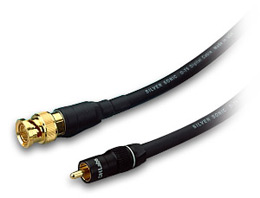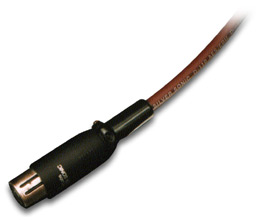
D-75 with RCA connectors (bottom) and optional BNC connectors (top).

D-110 with XLR connectors.
|
When separate digital-to-analog converters and CD
transports emerged on the market, essentially splitting a CD player into two chassis, I
could accept the fact that I now needed a digital cable -- after all, the digital
data read from the CD had to somehow get from the transport to the DAC. What I
couldn’t accept was that I needed an expensive digital cable. All the cable
had to do was get a series of ones and zeros from one point to another. Computers do it
all the time, reliably, at low cost, using wire that costs a fraction of what audiophile
stuff does. How tough could it be?
I wasn’t the only one with such thoughts. The
arguments about digital cables are similar to the debates about amplifier sound that have
been going on for decades. On the one hand are those enthusiasts who say that, in terms of
the needs of a home-audio system, cables should be indistinguishable from each other --
like those who say that two well-designed solid-state amplifiers should be
indistinguishable. When digital cables came into the picture, the arguments of these folks
only strengthened: after all, now we were dealing with bits and bytes, not analog audio
signals. On the other hand, as in the amplifier world, are those enthusiasts who can hear
the minutest differences among almost all cables, whether used to carry analog or digital
signals, and can expound at length about those differences.
The tactics some cable makers use to sell cables, not to
mention the prices that some charge, have caused many to view the cable trade with the
same caution that others do religious cults, sports supplements, and self-help experts. A
lot of mumbo-jumbo and marketing hype are used to sell cables today; when you start to
look seriously at it all, you realize that, well, it often doesn’t make a whole lot
of sense.
But DH Labs and their Silver Sonic line of cables do make
sense -- so much sense that the practicality of it all sometimes scares away more
mystically inclined audiophiles. I’ve known the company a long time, and I’ve
never heard company president Darren Hovsepian say anything that puts the needle of my
B.S. meter in the red zone. No hype, no mystique, and most of all, no high prices.
DH Labs’ first products were the Silver Sonic BL-1
analog interconnect and T-14 speaker cable, which both debuted in the mid-1990s. They had
copper conductors plated with silver -- hence the name -- and cost practically nothing
compared to what audiophiles were used to paying for high-end cables. Those who listened
more with their ears than with their pocketbooks (and eyes) scooped them up by the
boatload. A new, practical cable company had been born.
Today, DH Labs is a far larger operation with a more
impressive array of products, but their commitment to value appears unchanged. The D-75
and D-110 digital interconnects are priced at $75 and $89, respectively, for 1m lengths.
While that may seem a fair chunk of change for those used to out-of-the-box cables,
it’s actually a fair price, given the quality of construction and the performance the
DH designs offer. In fact, they may be the last digital cables you’ll ever need to
buy, regardless how expensive your system is.
Description
Like the rest of the DH Labs line, the D-75 and D-110 are
no-frills, no-nonsense designs: well-made, properly terminated, and of good quality.
They’re just not cosmetically showy. That’s okay, though, because showy, in
high-end-audio terms, usually means expensive.
The D-75 cable is for S/PDIF coaxial-type connection, and
the D-110 is for AES/EBU-type balanced connection. AES/EBU is generally considered the
superior connection method, provided your transport and DAC both support it. If
not, your transport and DAC will likely have an S/PDIF coaxial connection that will use
RCA or BNC connectors. When faced with S/PDIF, I prefer the BNC method of connection, but
if your components have only RCA jacks, don’t sweat it -- you’re not missing
that much.
The D-75 is a basic, black-jacketed 75-ohm digital cable.
Its $75 price includes RCA terminations; if you want BNCs on both ends, add $25; for BNCs
on only one end, add $12.50. A 0.5m length costs $10 less, additional meter lengths $20
each. If you want to buy the cable without RCA or BNC connectors so that you can
roll your own terminations, the price is $4.50/foot.
Similar rules apply to the 110-ohm, maroonish-brown D-110:
$79 per 1m length, $69 for 0.5m, $20 per additional meter length. AES/EBU cables use only
XLR-type connectors, so there are no options there; the XLRs supplied by DH Labs are very
good.
I used the D-75 in my reference system with a Theta Data
Basic transport. Since my Theta doesn’t support AES/EBU, a Simaudio Nova CD player
with an AES/EBU output was used as a transport for the D-110. The DACs in question are the
astonishingly expensive, reference-level Weiss Medea and Zanden Model 5000 Mk.II, which
support both digital connection formats. This equipment, particularly the DACs, is far
more expensive than most audiophiles own, but I figured it would reveal everything about
the cables’ performance.
Performance
Unlike many, I do hear differences among digital cables.
However, I also believe that if a digital cable is properly designed for the specific type
of connection (not all are), then the differences between even a relatively low-priced,
properly designed cable (such as the DH Labs designs), and cables that cost hundreds of
dollars more, will be slight to nonexistent. My reference cable, for example, is a
BNC-terminated i2Digital X-60, which retails for more than twice the price of the D-75
with BNCs, but still far less than what it’s possible to pay. I haven’t heard
any better than the X-60, which -- skinny and white, with more attractive connectors --
certainly looks more sexy than the D-75. The sonic performances of the X-60 and
D-75 were exceedingly close -- but the visual differences between them were far greater.
I like to use the soundtrack album of The Mission [Virgin
90567-2] to evaluate digital components -- transports, DACs, and cables alike. Ennio
Morricone’s large-scale music is choral and orchestral, primarily in performances
that tax digital gear. But with the digital electronics I have and a cable like the D-75,
I could unravel a wealth of detail that lesser components obscure.
For example, "Falls" begins lightly and builds to
the full weight of the orchestra. Poor-performing digital cables obscure the bass with a
notable reduction in texture and detail -- things become lumpy and diffuse. With the D-75,
as with my reference X-60, when the orchestra fills in, the bass had great depth that
rumbled with detail -- when the bits and bytes were all traveling right, the sound gained
texture down below. Engineers tell me the improvement is likely due to the signal’s
having fewer jitter errors (i.e., timing-related distortions induced by
poor-performing cables, connections, or other components), but I don’t know for sure.
I can only tell you what the result sounded like.
"Gabriel’s Oboe" is great for evaluating
detail. At the beginning of the track, a drum is played far, far back in the soundstage.
With lesser digital cables, the resolution can be reduced enough that the striking of the
drum becomes obscured, losing impact and immediacy. But when everything’s right,
every nuance of the drum being struck can be heard -- and more, including better
re-creation of the soundstage space: I can hear the precise depth and left/right position
of the drum, as well as its size in relation to the other instruments and performers. The
D-75 got it all right, but when I played this same recording using a bare-bones, no-name
digital cable that I’ve had in the house for years -- mostly to prove to people that
digital cables do matter -- the impact of the drum and the depth were not only
lessened, but the instrument itself became slightly more diffuse. In short, a
good-performing digital cable can enhance precision in many ways.
Similar things could be heard even on simpler recordings,
such as Willie Nelson’s outstanding Stardust, from 1978 [Columbia 65946]. The
CD version, remastered in 1999, has a clear and detailed sound that does justice to this
terrific record. "Georgia On My Mind" places Nelson’s highly textured voice
starkly in the mix. The D-75 let me hear all the detail in his voice, and the ambience
that spreads around him like a glow. When I switched in the X-60, I heard the same thing.
But with the no-name cable, the stage lost some depth, the ambience wasn’t quite as
apparent, and the voice lost just a touch of starkness and immediacy.
I actually found the D-75 and X-60 indistinguishable when
played through the Weiss DAC, partly because Weiss goes to great lengths to isolate the
Medea from external jitter from the transport or connecting cable, and partly because, of
course, the D-75 is a great-sounding digital cable. Where the X-60 edged out the D-75 was
with the Zanden DAC, which is not so immune to cables and transports. The X-60
sounded the slightest bit more precise, and resolution was a tad better. It was the
smallest difference, but it’s here that paying more money than you would for the D-75
might be worth it.
The D-110 seemed to perform to the same level as the D-75;
however, directly comparing the D-75 to the D-110 is impossible. For a comparison to be
valid, you can change only one variable at a time; in the case of cable comparisons, that
would mean switching out nothing but the cables. But the D-75 and D-110 each use a
different type of termination, which inserts a second variable. The only thing I will say
is that, all other things being equal, in general I’ve heard properly implemented
AES/EBU connections outperform S/PDIF coaxial connections -- as I did to a lesser extent
with the Weiss, and to a greater extent with the Zanden. If you can choose one type of
connection, choose AES/EBU, though that choice will depend on what your equipment
supports. But don’t buy a specific transport and DAC just to get AES/EBU.
Implementation is everything; it’s possible to get stellar sound from either type of
connection.
Conclusion
DH Labs’ Silver Sonic D-75 and D-110 won’t win
awards for glitz and glamour, but these no-nonsense, well-made cables do deserve praise
for delivering great performance at a reasonable price. If you find something as good as
or better than for less, more power to you -- the people I’m addressing here are
those willing and able to pay more: Regardless of the price of the associated
equipment, I recommend trying either of these DH Labs digital cables before considering
something more expensive. I found that they rivaled the best out there. Why pay more if
you don’t have to?
Prices of equipment reviewed
|